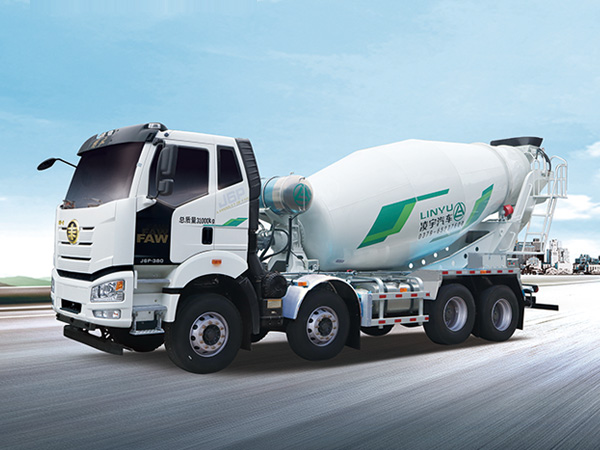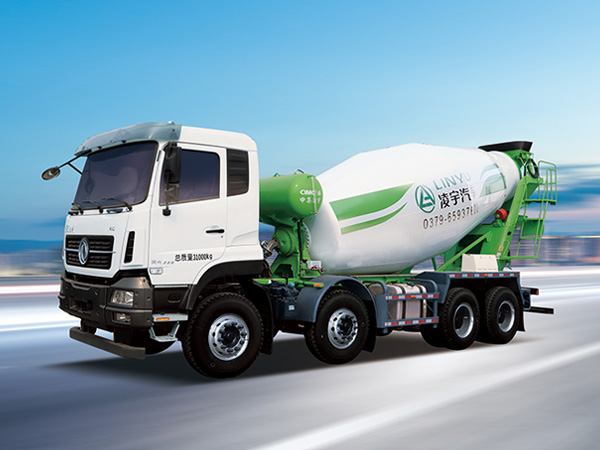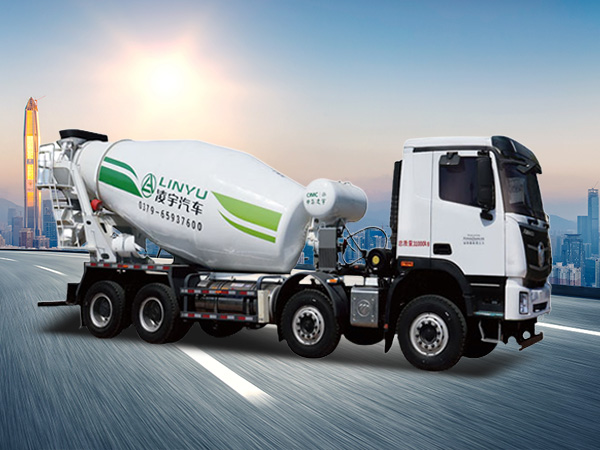The mixing drum is the key component of the concrete mixer truck for loading, mixing and transporting concrete. A flange is welded at the head of the mixing drum, and a raceway is welded at the rear cone. The mixing drum is driven by the reducer, and is supported by the rollers in rolling contact with the raceway to rotate, so as to realize the loading and unloading and mixing functions of concrete. Due to the eccentric load generated by the concrete mixer truck during mixing and the starting and braking of the vehicle on complex roads, the force on the mixing drum is extremely complex, and the design or welding process defects may lead to cracking of the raceway welds. The concrete mixer truck manufacturer analyzes the cause of the cracking of the raceway weld and proposes a repair plan.
When the mixing drum is working, in addition to the bending moment caused by the self-weight of the drum and the weight of the concrete, it also bears the torque action caused by the rotary motion of the mixing drum and the force of the concrete in the circumferential and axial directions in the mixing drum. force is more complicated. Under the action of cyclic alternating load, initial micro-cracks may form in areas of high stress, and then develop into macro-cracks, and then the macro-cracks will continue to expand, eventually leading to cracking of the weld bead or base metal.
The main reasons for the initial microcracks affecting the raceway are as follows:

(1) Stress concentration at the raceway weld
Reason: When the raceway and the cylinder are welded, stress concentration often occurs at the weld. In addition, during the use of the mixing drum, the concentrated load at the raceway and the supporting roller and the overall deformation of the raceway section will also cause stress concentration at the weld.
Countermeasures: Grind the stress concentration weld and re-weld. For the weld or base metal with macro cracks, punch holes to cut off the source of the crack and re-weld.
(2) Residual stress at the raceway weld
Reason: The rigidity of the raceway and the cylinder body is very different. In general, the thickness of the mixing drum is 6mm. The radial thickness of the raceway is about 60mm. The thickness of the cylinder and the raceway is very different. During the welding process, The thermal expansion of the raceway is limited, and the shrinkage during the cooling process is also limited, and the degree of limitation of the cylinder is much smaller than that of the raceway, which ultimately affects the size and uneven distribution of welding stress, resulting in the generation of residual stress.
Countermeasures: Adjust the welding sequence, reduce the single heat input, tap the components with a red copper hammer during the welding process, and use the vibration aging method to adjust, homogenize, and eliminate residual stress. In addition, the weld bead is partially ground to reduce welding defects.
(3) Rigidity change of raceway and cylinder
Reason: The stiffness of the raceway and the cylinder decreases with the use of the vehicle, especially for the large-scale mixer. The weakening of the stiffness will accelerate the fatigue failure of the weld bead, resulting in cracking of the weld bead or base metal.
Countermeasures: Welding reinforcement plates are added inside the contact between the raceway and the cylinder to improve the overall rigidity of this area, so as to enhance the fatigue failure resistance of the welded structure.

When the welding seam cracks between the mixing drum and the raceway, the corresponding repair scheme can be selected according to the different degree of welding seam cracking.
(1) Circumferential local weld cracks appear in the raceway of the mixing drum
Because it is a local weld crack, it is necessary to control the continuous cracking of the raceway weld crack. Grind out a V-shaped groove with a width of ≥5mm and a depth of ≥4mm along the circumferential girth weld of the raceway, re-weld, and paint after welding.
The specific welding scheme is as follows:
1) First, clean the original welding seam by extending 50mm at both ends of the cracked area; manually grind the original weld bead with a hand-held grinding wheel grinder, and use a polisher to grind off the carburized layer of about 1mm to ensure that the raceway and the cylinder are Expose the metal itself; remove oil, rust, paint, oxide skin, concrete, etc. within 20-30mm around the welding site.
2) Use short arc welding to keep the arc stable, and use two layers of welding bead for welding; the surface of the cover layer after welding is smooth, each welding seam is even and straight, and there should be no obvious grooves and other defects between each welding. After the seam welding is completed, a small pointed hammer with rounded corners should be used to hammer the welding part immediately to relax the internal stress; after the welding seam defect is repaired, the weld bead should be polished to remove the spatter.
Because the base metal of the mixing drum is partially cracked at the weld, it is necessary to grind a V-shaped groove with a width of ≥5mm and a depth of ≥4mm along the circumferential girth weld of the raceway; drill a φ10 crack-stop through hole at the end of the crack; Grind off the weld bead with a length of about 100mm, and then weld according to the above welding plan. The welding bead of the base metal of the mixing drum needs to be ground and painted after welding
(2) All the welds on both sides of the mixing drum raceway are cracked
This phenomenon generally occurs on mixer trucks that have been used for 2 years or more. In view of this situation, it is necessary to plan all the circumferential welds on both sides of the raceway, grind out a V-shaped groove with a width of ≥5mm and a depth of ≥4mm, re-weld, and paint after welding; The ring reinforcement plate can improve the strength and rigidity of the tank, disperse the concentrated load of the tank at the raceway, and improve the bearing capacity of the tank.
It is characterized by:
1) The width of the reinforcement plate is 200mm and the thickness is 1 times the thickness of the cylinder body. The reinforcement plate is evenly distributed with oblong holes. The two sides of the reinforcement plate and the cylinder are welded and fixed by angle ring welds.
2) When the reinforcement plate and the cylinder are welded, the oblong holes on the reinforcement plate should be staggered relative to the welding holes of the cylinder and the raceway oblong plugs.
The specific welding scheme is as follows:
1) First, remove the concrete, oil stains, rust spots, paint, oxide skin, etc. on both sides of the raceway and within 150mm of the inside of the cylinder; use a polisher to polish the welding parts until the sides of the raceway and the inside of the cylinder are within 150mm of the range If new base metal appears, carbon arc gouging equipment can also be used to remove the original weld bead and root.

2) Considering the limitations of the construction site on site, in order to ensure the positioning of the raceway, the welding seam cleaning sequence is: grinding one side of the welding seam → welding the girth seam → grinding the other side welding seam → welding the girth seam.
3) The internal reinforcing plate is assembled in sections. When splicing, the reinforcing plate needs to be tapped with a copper hammer until it fits with the cylinder; the internal reinforcing plate of the cylinder is welded, the circumference is fully welded, all plug welding holes are fully welded, and the weld bead is polished.
4) One layer of weld bead for the reinforcement plate, two layers of bottoming and three layers of cover for the weld bead on both sides of the raceway. The surface of the cover layer shall be smooth after welding.
The raceway is the main supporting component of the mixing drum, and the cracking of its welds directly affects the normal operation of the entire mixing drum and poses a certain safety hazard. This paper discusses the cracking of the raceway weld of the mixing drum, analyzes the reasons for the cracking of the raceway weld, and proposes an effective repair plan.What are the advantages of chemical liquid trucks?
What are the precautions for the use of concrete mixer trucks
CIMC Vehicles achieves two major market victories! Bulk deliveries of concrete mixer trucks to North and Northwest China demonstrate strong brand power.
2025-12-01 14:01CIMC Vehicles & Shaanxi Automobile New Energy Mixer Trucks: Mixing Big Things with Strength!
2025-12-01 11:30Narrow roads? Side streets? Troublesome roads? This car is the perfect solution for "difficult roads"!
2025-11-24 16:48The factory area boasts scenic views, and production is environmentally friendly, showcasing how a concrete mixer truck can "load" a mountain of greenery.
2025-11-18 17:15Address:Zhangheng Street corner Guanlin Road, Science and Technology Park, Luolong District, Luoyang City, Henan Province
E-mail:shiyk@lingyu.com
Phone:0086-379-65937678